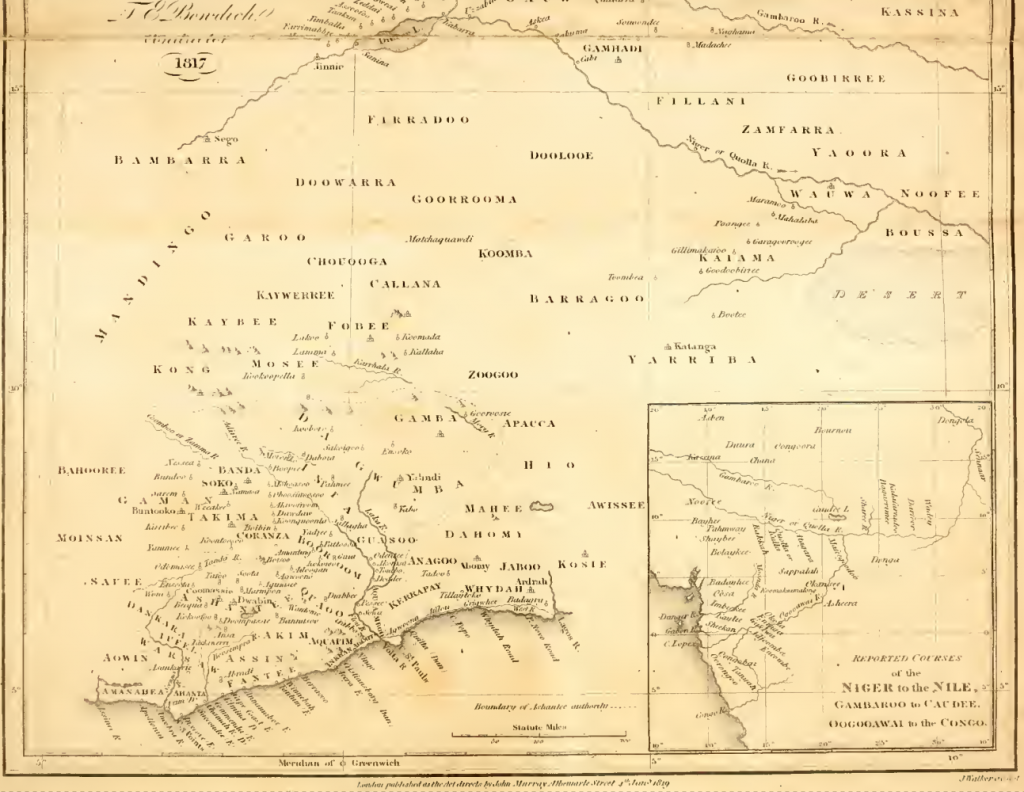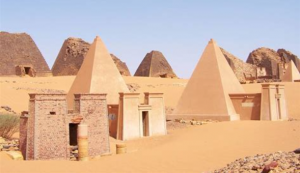In meandering through ancient sources and texts, I chanced upon a gem of an article by Thomas Edward Bowdich, an English intellectual who was known to have made inroads into Asante territory in the early part of the nineteenth century. Now, Bowdich is known for another book he wrote about interactions of the British Empire (at the time) with the Asante. That book is titled Mission from Cape Coast Castle to Ashantee, with a statistical account of that kingdom, and geographical notices of other parts of the interior of Africa. As the title of this book (published in 1819) suggests, it is more about a government mission such as one that an ambassador or representative of one government will make to another.
It is however another publication that Bowdich published, two years after the first, that has really caught my attention. This second publication (almost book length) is titled An Essay on the Superstitions, Customs, and Arts, Common to the Ancient Egyptians, Abyssinians, and Ashantees. As the title of this second book suggests, it is more of an academic paper or contribution than it is a report on a mission conducted on behalf of one’s government. Indeed, this paper is written as an academic treatise, replete with references and with links to academic sources not only of the British but also of the French and of other European sources.
In this publication, Bowdich appears to demonstrate his genuine surprise for having discovered an incongruity in the heart of West Africa. That incongruity is the apparent similarity of Akan culture with that of Abyssinia (think also Nubia-Kush) and also with Ancient Egypt. I think it surprised Bowdich that the Akan people were as cultured as he perceived them to be. He in fact states something to that effect. Because of this surprise, Bowdich was forced to consider other possibilities. His considerations led him to posit that the Akan people had at some point come into contact with the culture of Ancient Egypt. It is to Bowdich’s credit that he demonstrates degrees of erudition. This man clearly knew (or at any rate researched) his ancient history. In this second publication, he makes remarkable displays of his knowledge of ancient history (c.f., that of Ancient Egypt, of Abyssinia, and that of historical sources from Ancient Greece and Rome, all to support the positions he argues in the publication).
In this regard, Bowdich was perhaps among the first of the intellectual white people (perhaps some missionaries also did this as well) to realize that the culture that was displayed before his eyes when he visited Asanteman (i.e., the Asante nation) was reminiscent of those cultures which existed in Kemet (Ancient Egypt) and in Kush (Nubia), also Abyssinia/Ethiopia, because all these are part of the same overall culture. Bowdich thus before Eva Meyerowitz (and even before R. S. Rattray), was able to discern that Akan traditions and customs were the same as those of the peoples of Ancient Kemet and Nubia. Of course, Eva Meyerowitz appeared over a century later, to discern the same truth. Her book, titled Divine Kingship in Ghana and Ancient Egypt (published in 1960), went to great lengths to demonstrate connections between Akan and Ancient Kemetic cultures. In the case of Meyerowitz, the primary Akan people she interacted with through whom she had her epiphany, or discerned the parallels between the two cultures, were the Bono Akan people of Techiman and neighbouring areas. So here, we have two different Akan groups, first the Asante, and then the Bono, both of whom are (if we are to be honest, or at least I should say, in my view) really one and the same people. Different factions of the same clan, the Dakon/Oyoko clan, or the falcon clan, the same people known in ancient times as Hathor’s people (Hathor means Hut-Heru – house of Heru (Greek Horus), the falcon deity of Ancient Kemet). This, Meyerowitz shows in her books, and I have also argued the same point in my books, drawing on evidence from her and from other sources.

But back to Bowdich, who is the subject of this post. Bowdich clearly understood that Elephantine (of which derives the name of the Akan group Fante – my emphasis, and an point which is also emphasized by AkanBa, author of The Movement of the Akan from Kanaan to Ghana) and Thebes were Nubian/Kushite people, of whom ancient writers such as Herodotus (Ancient Greek) and Strabo (Roman) often referred to generically as “Ethiopians”. In particular, Bowdich mentions the Nubian pharaoh Sesostris (i.e., the Kemetic pharaoh Senusret III), who, having reigned for about 40 years as a wise and just king, retired to Nubia. The manner of rule of Senusret III was seen in the manners of the wise people I have recently been calling the “DiaMo” rulers of old (the “DiaMo” are the Lion clan people, such as those of the Ethiopian dynasty, and many other groups in West Africa, in East Africa, and further south) , who are still here today, all over Africa, those who have also been referred to as the “Ancient Hebrews”, and who were the subject of the book Hebrewisms of West Africa, a book to which we shall return later in this post.
Basically, Sesostris/Senusret III was well known in the ancient time in Europe (to be quoted by Herodotus and Strabo) because he built an Egyptian empire that spanned much of the ancient world around the region, extending even into Europe. This is historical fact. He was basically a Nubian (i.e., a black man) who was the major Pharaoh of the twelfth dynasty. As I have been saying of late, the only times that both lower and upper Egypt were united were when they were ruled by black dynasties. This happened in three distinct eras or time periods far apart in the history of Ancient Kemet which I have published on. One of those eras was when Senusret III ruled.
Bowdich, unfortunately, as some other European writers of his era, appears to maintain the view that the peoples of Kemet civilized the Nubians/Ethiopians. In fact, there was cultural exchange between the two peoples over millennia, because in both Kemet and Kush/Nubia, there were significant populations of black peoples. It was similar to those wars and interactions among Akan peoples, before and during the time of European colonization, where one Akan power would be pre-eminent, only for another to take over after a time. In the end, the Asante emerged the strongest political power in the region of Akan people, but there were others before them. Bowdich (1821) tells us that:
“Having thus separated the barbarous Ethiopians, by identifying them with the cannibal nations still retaining such of their customs as are briefly recorded, and found the same geographical situation, I will return to the Ashantees, whom I consider to be part of the civilized Ethiopians of Herodotus and Diodorus, pressed westward by Egyptian emigrants (by an intercourse with whom they had nevertheless acquired most of the arts, customs, and superstitions which now surprise us), and afterwards driven or compelled to emigrate still further westward, by the sweeping expedition of Ptolemy Evergetes” (p. 10)
So here, Bowdich, in a fashion common to many European intellectuals of his era, notices that Asante and Ancient Egyptian culture bear strong parallels beyond mere coincidence. His explanation for this fact is the notion of “borrowing” of culture by the Asante from the Ancient Egyptians. It did not seem to occur to Bowdich that perhaps the Asante were in fact the Ancient Egyptians, or more correctly, that the culture of the Asante and other Akan peoples is directly descended of that of Ancient Egypt. In this latter scenario, there would be no need for “borrowing”. This is the culture of the black people since ancient times. Bowdich also mentions emigration west which, rather than being due to Ptolemy Evergetes (which, admittedly could have been an effect at a later time), was first instigated by incursions of Asiatic peoples into the lands of Kemet. Those, such as the Hittites and others, coming into Ancient Kemet, caused the blacks of the time to consider leaving their homes. These Semitic peoples, descendants of the Mesopotamian Annunaki and their patrilineal culture, did not mix well with that of the peoples of Ancient Kemet. The culture of the peoples of Ancient Kemet and Kush, and Abyssinia, then and now, has a strong influence of the matrilineal.
This was long, long before Islam entered the scene (i.e., we’re talking the last groups leaving Kemet and Kush around 2,300 years ago, or around 300BC). The first exodus of blacks from Kemet into the heart of TaMeri (Africa), was brought about by incursion of culture into Kemet that was contrary to their own. The matrilineal blacks who did not want to submit to the patrilineal culture (forcefully, or perhaps we could say, out of necessity) decided to emigrate. The alternative was forced assimilation. Forced assimilation eventually ‘killed’ the matrilineal culture in successive fashion from Kemet and Kush, throughout much of Western and Southern Africa, leaving now only pockets of this culture which includes the Akan and the Dogon (as examples), as well as several other small groups in West Africa. Often among blacks especially in West Africa, where there is an overarching patrilineal structure, if one looks more closely, they find an underlying matrilineal influence. This latter influence tends to reflect in the spiritual life of the people, whereas the political life reflects the patrilineal.
Of this influence deriving from the matrilineal, we learn from Bowdich (1821)’s perceptive mind how the Abyssinians, and the Asante are similar:
“Marriage in Abyssinia is but a civil contract, subsisting only until dissolved by the wish of either party, which is extraordinary, considering their attachment to the Christian religion: so, in Ashantee , the mere return of the marriage present to the husband by the wife’s family, on her dissatisfaction, dissolves the contract. In both countries the property of the wife received from her own family, is always enjoyed and disposed of independent of the husband.” (p. 32)
Here, we see the power of the matrilineal institution of both people. Even today, in Akan regions, this institution is still strong and vibrant. It should not surprise us that Abyssinia and Akan are similar, given that the Abyssinians are led by a “DiaMo” (i.e., Lion clan) dynasty, and also that about a third of present-day Akan are of the DiaMo people. This is the “Hebrewism” connection, since the Hebrews (Sephardic) can be called “DiaMo” people as well. “DiaMo” basically refers to a breakdown of the peoples deriving from the 5 sons of Noah. It is said that the 5 sons of Noah were responsible for the creation of the nations of Elam, Assyria, Syria, Chaldea and Lydia, of which are derived Arabic, Aramaic, Akkadian, Kushite/Nubian, Ancient Hebrew/Ancient Egyptian and Phoenician peoples. Of these, some of the Aramaic (e.g., the Tuareg), as well as the Kushite and the Ancient Egyptian/Hebrew (i.e., all the DiaMo peoples across African groups), I know that at least these three (i.e., some Aramaic, along with the Nubian/Kushite, and the Ancient Egyptian/Hebrew) have matrilineal institutions.
With the matrilineal institutions, such as those of the Akan, we can find how powerful the maternal clan is. The clan, and in fact the state, we should say is owned by the Queen mother, among the Akan people. This goes as deep as it gets. The Queen Mother births the state. It is from the Queen Mother’s line that the chiefs and the kings emerge, in each generation. The Queen Mother, being the owner of a state, can therefore do certain things that show this ownership. To underscore some of this, we learn the following from the book Hebrewisms of West Africa:
“In I922, on the occasion of the wedding of the Princess Mary, the Queen Mothers of Ashanti sent as a wedding-gift, a silver stool which was a replica of that belonging to the late Queen Mother of Mampon. Their address to Lady Guggisberg, wife of His Excellency the Governor, gives us some idea of the reverence in which the Ashanti hold the stool, as well as its symbolism. “I place this stool in your hands. It is a gift on her wedding for the King’s child, Princess Mary.” (p. 53)
I do not know if Akan chiefs or even an Akan king can do this, but the Queen Mothers did this.
It is also from this same latter book that we learn that Professor Dixon, one of the most well known (as well as one of the most critical) scholars of his time hinted to the truth that many African groups around the continent today have their roots in Ancient Kemet. The British intellectuals knew this. Perhaps, some of them were uncomfortable with this truth, but as an honest intellectual, how can one discount the truth, and still maintain one’s dignity as an intellectual of authority and standing? One cannot. A recourse then, might be to downplay or to set aside altogether a finding. Especially in the instance where you are now a representative of the world power. I speak hypothetically, of course 😀
Here is the quote:
“From all that Professor Dixon has said, we may gather that more than one ethnic impulse has passed from Egypt out through the continent of Africa, and we hope to show that in some way an influence of Hebraic culture found its way along the same lines from Egypt to the heart of Negro Land. To establish this theory, it becomes necessary to study the possible historic contacts between the Hebrews and the tribes of West Africa.” (pp. 114 – 115)
Again, one need not necessarily study “possible historic contacts”. It’s the same people. Granted, there are different constituents or ‘proportions’ of these DiaMo people, spread across all of black Africa (as well as among the non-black peoples of North Africa). That is what needs to be studied.
Finally, returning to Bowdich, and ending with his 1821 publication, we learn of yet another fascinating way that Ancient Egyptian, Abyssinian, and Asante (of we could think of it as the greater Akan group) share common traditions:
“The Abyssinians, like the ancient Egyptians, never fight in the night, neither do the Ashantees, not even after sunset, whatever advantages they may lose.” (p. 32)
Related blog posts
Numenor as Atlantis – the truth and untruth of a TV series
Why Akan, Igbo and Aztec have the same root
Imhotep, step pyramids and the buried pyramids of Africa
Why the Jews call themselves “the Chosen People”
Decoding the name of the Yucatec-Mayan deity Kukulkan
Sirian-Reptilian influence and the Gurdjieff work
On the Akkadians, the Assyrians and the Sumerians
Article Themes: Sephardic Hebrews, Biblical peoples, Ancient Egyptians, Kush/Nubia



